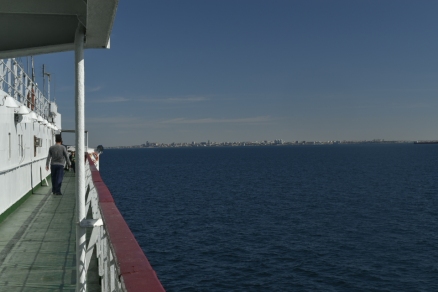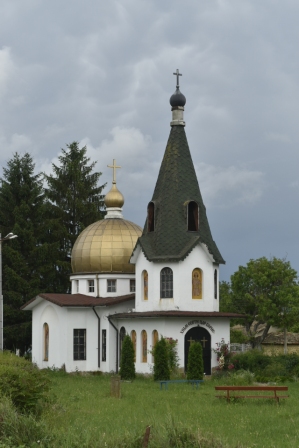Category Archives: Practical
Sumatra continued – Photos
Clare in the Town
Gideon
Clare in a Paddy
Gideon
Clare on the Beach
Clare in the Quarry
End
Cheap As Chips?
A tiny blog posting – a Micropost!
I thought it would be interesting to see how the countries we pass through compare economically. Thanks to Wikipedia, it’s pretty easy.
Here’s a chart showing the Per Capita Income in each country we’ve passed through, or hope to pass through.

And here’s the same chart, adjusted for the cost of living in each country (called Purchasing Power Parity, or PPP).

PPP seems to have the effect of making the people in middle-income states better off. And Singapore.
We can even divide one by the other, to give us a rough Cost of Living Cycling. However, this is a bit rubbish, as in most of Europe, costs were kept down by camping. From about Bulgaria/Romania onwards, it felt a bit insecure rough camping, and hot – we really appreciated the comfort of a shower, so mostly stayed in guesthouses and cheap hotels. In tourist cities, that was often pretty cheap, but out on the road, I would guess that it very often was close to $20/night for a room for the two of us, irrespective of country. So far the most expensive nights have been Uzbekistan ($70 for a yurt), India (~$70 for a tent, ~$40 for a palace (really it was, gorgeous)), and Myanmar ($50 at two of the hotels, trading on scarcity). Not normally regarded as high-cost locations. The Caspian Sea ferry was also an expensive night, but did cover a fair bit of ground as we slept. The Tajikistan Toyota Tour was by far our most expensive week, but wasn’t exactly integral to the trip. And it didn’t include the (cheap) guesthouses!

Turkey, Uzbekistan and India have been most costly for souvenirs, not because of prices, but because of the wonderful handicrafts, and their availability, and perhaps more stop days, and maybe the timing of Christmas.
End of micropost!
(Note to self – master spreadsheet stored on cloud, in case plans change!)
Uzbekistan – On the Road
Uzbekistan had so much to see, do and snap, that we made a number of themed blog posts, instead of trying to tell one story. We hope this posting will give an overview of our tour in Uzbekistan, and show of the pictures we took between the “sights”.
Our posts on Uzbekistan:
- To and through the Uzbekistan border (we entered 11th Sept, towards Kungrad)
- The Aral Sea, or rather Not the Aral Sea
- Crossing the desert is gruelling. (up to Nukus, more or less)
- A night in a yurt at Ayuz Kala (between Nukus and Khiva)
- Photo gallery – The ancient silk route cities (Khiva, Bukhara, Samarkand)
- A night to remember (Bukhara to Samarkand by train)
- (to come) Ferghana Valley (side-trip by train)
- We left Uzbekistan 8th Oct, via the foot crossing en route to Shymkent.
Uzbekistan’s roads were generally good to us. We were often on main roads, which were often dual carriageways. But this was rather like Turkey – there was plenty of room and not too much traffic, albeit the roads were not as smart and new as Turkey’s. It was flat. And it was sunny but not too hot. Not too much wind. Out of the desert, there were plenty of little shops and teahouses. Really nice touring conditions. The only bugbear was trying to comply with the hotel registration rules. We mostly managed this, with a few deviations into teahouses.
Uzbekistan’s people were invariably friendly and helpful. We were often flagged down, or addressed from a car crawling alongside: “atcuda, atcuda?” – Russian for “where are you from”. Strangers rushed to take pictures of themselves, or their friends and family, with us. In towns especially, young people would come up and ask to practice their English with us. We were, of course, given melons. And one lovely family invited us in, with delicious food in the local style, and the extended family all joined in too. That was an especially lovely experience, and we thank them again for their kindness.
Just before we got to Uzbekistan, on the ferry, Clare had a severe, if short, bout of food poisoning, and Gid’s tummy was a bit uneasy as well. The timing of it made us suspect a pre-ferry pasty rather than the actual ferry food. But Clare’s tummy then kept suffering from recurring problems which had us calling on pharmacies as we went along. It wasn’t desperate, but the overall effect was weakening and depressing. We took a few extra rest days in an attempt to ease the impact. With various tummy pills and a very plain diet it was sort of kept under control. We needed rest and a long break stop, but the Uzbekistan visa was only 30 days. Whereas we’d always planned a long stop in Bishkek (visa free for 60 days). Thus we altered our plans a bit:
Original Plan: From Samarkand, south into Tajikistan’s capital Dushanbe, then loop south taking the Pamir Highway along the Afghan and China borders, then north into Kyrgyzstan, Osh, then Bishkek. A classic, but tough ride, and in the back country.Plan B: From Samarkand, north to Tashkent, then east over mountains into the Ferghana valley (this road might’ve needed our Tajikistan visas. Across this valley; flat, fertile & historic (have you heard of the Bactrian empire?), to Osh in Kyrgyzstan, then north to Bishkek. Less back country, and three significant passes to cross, but easier and shorter than A.- Plan C: From Samarkand, north to Tashkent, then north to Shymkent in Kazakhstan, then east to Bishkek. This route is pretty flat, and on major roads. This we took, and indeed were able to make pretty long distances most days.
Gallery
Cotton Picking
On The Road
Generous Hospitality

All Aboard

Baku
Istanbul – Getting In
Travelling South Across Bulgaria – Part 2
- Urban area 1cm or more on map: Will have most facilities. Choice of hotels but obvious ones may be pricey. Probably a nice centre bit. Big enough to get lost in.
- Urban area 5mm to 9mm. There will be at least one hotel/motel/guesthouse. You may have to ask around in shop or street corner to find it. It may be on the edge of town. It will probably be 40-60 Bulgarian (20-30 euro) for room for two, excluding any food. There will be an in-hotel or nearby restaurant. There will be more than one food shop, and they will have fresh fruit and reasonable bread.
- Big dot. No place to stay. Some kind of bar or cafe (may not do hot drinks). One shop, at extreme edge of viability: No fresh products, bread may be mouldy or end dated; vaguely disquieting smell. Difficult to get even UHT milk, or cheese. Although a fresh cheese is sometimes available from a concealed bucket. This is an interesting contrast with Romania, where little village shops were normally selling fresh bread, and tomatoes, cucumbers at least, and generally seemed viable.
- Small dot: Just houses, a good proportion falling down.
Ready Bikes!
Here they are, loaded & ready to go…. For another weekend shakedown tour. Turns out we forgot the fuel pump and had a stripped gas bottle thread. That’s why we have shakedowns.

Clare’s at the front. Thanks for the retirement pressie solar panel draped over the back there. They’re probably 40-45 kilos each. Glad we squeezed slightly lower gearing on a little while ago.
(First post from a phone, too, rather hard work!)


































































































































































































